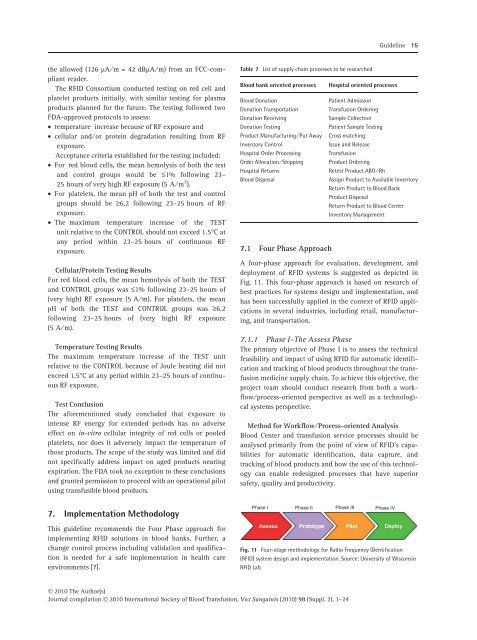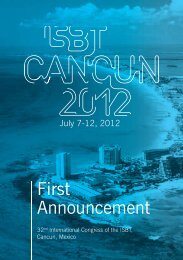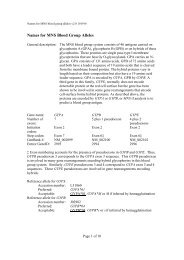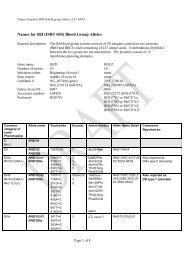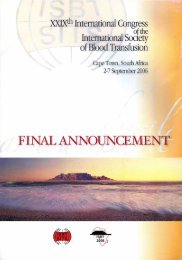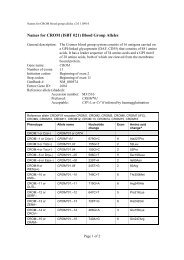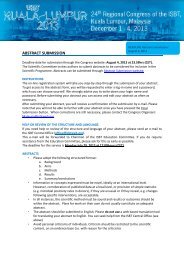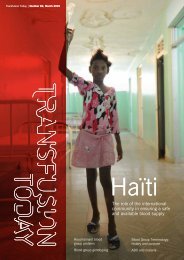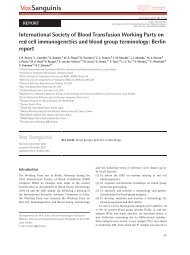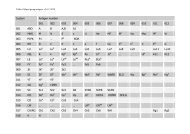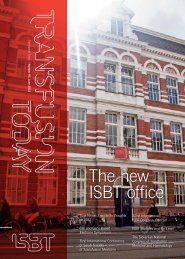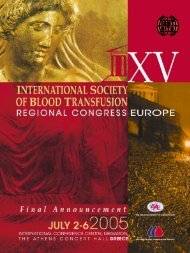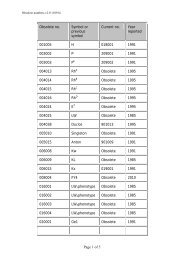Guidelines for the Use of RFID Technology in Transfusion Medicine
Guidelines for the Use of RFID Technology in Transfusion Medicine
Guidelines for the Use of RFID Technology in Transfusion Medicine
You also want an ePaper? Increase the reach of your titles
YUMPU automatically turns print PDFs into web optimized ePapers that Google loves.
Guidel<strong>in</strong>e 15<strong>the</strong> allowed (126 lA ⁄ m = 42 dBlA ⁄ m) from an FCC-compliantreader.The <strong>RFID</strong> Consortium conducted test<strong>in</strong>g on red cell andplatelet products <strong>in</strong>itially, with similar test<strong>in</strong>g <strong>for</strong> plasmaproducts planned <strong>for</strong> <strong>the</strong> future. The test<strong>in</strong>g followed twoFDA-approved protocols to assess:• temperature <strong>in</strong>crease because <strong>of</strong> RF exposure and• cellular and ⁄ or prote<strong>in</strong> degradation result<strong>in</strong>g from RFexposure.Acceptance criteria established <strong>for</strong> <strong>the</strong> test<strong>in</strong>g <strong>in</strong>cluded:• For red blood cells, <strong>the</strong> mean hemolysis <strong>of</strong> both <strong>the</strong> testand control groups would be £1% follow<strong>in</strong>g 23–25 hours <strong>of</strong> very high RF exposure (5 A ⁄ m 2 ).• For platelets, <strong>the</strong> mean pH <strong>of</strong> both <strong>the</strong> test and controlgroups should be ‡6.2 follow<strong>in</strong>g 23–25 hours <strong>of</strong> RFexposure.• The maximum temperature <strong>in</strong>crease <strong>of</strong> <strong>the</strong> TESTunit relative to <strong>the</strong> CONTROL should not exceed 1.5°C atany period with<strong>in</strong> 23–25 hours <strong>of</strong> cont<strong>in</strong>uous RFexposure.Cellular/Prote<strong>in</strong> Test<strong>in</strong>g ResultsFor red blood cells, <strong>the</strong> mean hemolysis <strong>of</strong> both <strong>the</strong> TESTand CONTROL groups was £1% follow<strong>in</strong>g 23–25 hours <strong>of</strong>(very high) RF exposure (5 A ⁄ m). For platelets, <strong>the</strong> meanpH <strong>of</strong> both <strong>the</strong> TEST and CONTROL groups was ‡6.2follow<strong>in</strong>g 23–25 hours <strong>of</strong> (very high) RF exposure(5 A ⁄ m).Temperature Test<strong>in</strong>g ResultsThe maximum temperature <strong>in</strong>crease <strong>of</strong> <strong>the</strong> TEST unitrelative to <strong>the</strong> CONTROL because <strong>of</strong> Joule heat<strong>in</strong>g did notexceed 1.5°C at any period with<strong>in</strong> 23–25 hours <strong>of</strong> cont<strong>in</strong>uousRF exposure.Test ConclusionThe a<strong>for</strong>ementioned study concluded that exposure to<strong>in</strong>tense RF energy <strong>for</strong> extended periods has no adverseeffect on <strong>in</strong>-vitro cellular <strong>in</strong>tegrity <strong>of</strong> red cells or pooledplatelets, nor does it adversely impact <strong>the</strong> temperature <strong>of</strong>those products. The scope <strong>of</strong> <strong>the</strong> study was limited and didnot specifically address impact on aged products near<strong>in</strong>gexpiration. The FDA took no exception to <strong>the</strong>se conclusionsand granted permission to proceed with an operational pilotus<strong>in</strong>g transfusible blood products.Table 7 List <strong>of</strong> supply cha<strong>in</strong> processes to be researchedBlood bank oriented processes7.1 Four Phase ApproachHospital oriented processesBlood DonationPatient AdmissionDonation Transportation<strong>Transfusion</strong> Order<strong>in</strong>gDonation Receiv<strong>in</strong>gSample CollectionDonation Test<strong>in</strong>gPatient Sample Test<strong>in</strong>gProduct Manufactur<strong>in</strong>g ⁄ Put Away Cross match<strong>in</strong>gInventory ControlIssue and ReleaseHospital Order Process<strong>in</strong>g <strong>Transfusion</strong>Order Allocation ⁄ Shipp<strong>in</strong>g Product Order<strong>in</strong>gHospital ReturnsRetest Product ABO ⁄ RhBlood DisposalAssign Product to Available InventoryReturn Product to Blood BankProduct DisposalReturn Product to Blood CenterInventory ManagementA four-phase approach <strong>for</strong> evaluation, development, anddeployment <strong>of</strong> <strong>RFID</strong> systems is suggested as depicted <strong>in</strong>Fig. 11. This four-phase approach is based on research <strong>of</strong>best practices <strong>for</strong> systems design and implementation, andhas been successfully applied <strong>in</strong> <strong>the</strong> context <strong>of</strong> <strong>RFID</strong> applications<strong>in</strong> several <strong>in</strong>dustries, <strong>in</strong>clud<strong>in</strong>g retail, manufactur<strong>in</strong>g,and transportation.7.1.1 Phase I–The Assess PhaseThe primary objective <strong>of</strong> Phase I is to assess <strong>the</strong> technicalfeasibility and impact <strong>of</strong> us<strong>in</strong>g <strong>RFID</strong> <strong>for</strong> automatic identificationand track<strong>in</strong>g <strong>of</strong> blood products throughout <strong>the</strong> transfusionmedic<strong>in</strong>e supply cha<strong>in</strong>. To achieve this objective, <strong>the</strong>project team should conduct research from both a workflow⁄ process-oriented perspective as well as a technologicalsystems perspective.Method <strong>for</strong> Workflow ⁄ Process-oriented AnalysisBlood Center and transfusion service processes should beanalysed primarily from <strong>the</strong> po<strong>in</strong>t <strong>of</strong> view <strong>of</strong> <strong>RFID</strong>’s capabilities<strong>for</strong> automatic identification, data capture, andtrack<strong>in</strong>g <strong>of</strong> blood products and how <strong>the</strong> use <strong>of</strong> this technologycan enable redesigned processes that have superiorsafety, quality and productivity.7. Implementation MethodologyThis guidel<strong>in</strong>e recommends <strong>the</strong> Four Phase approach <strong>for</strong>implement<strong>in</strong>g <strong>RFID</strong> solutions <strong>in</strong> blood banks. Fur<strong>the</strong>r, achange control process <strong>in</strong>clud<strong>in</strong>g validation and qualificationis needed <strong>for</strong> a safe implementation <strong>in</strong> health careenvironments [7].Phase I Phase II Phase III Phase IVFig. 11 Four-stage methodology <strong>for</strong> Radio Frequency IDentification(<strong>RFID</strong>) system design and implementation. Source: University <strong>of</strong> Wiscons<strong>in</strong><strong>RFID</strong> Lab.Ó 2010 The Author(s)Journal compilation Ó 2010 International Society <strong>of</strong> Blood <strong>Transfusion</strong>, Vox Sangu<strong>in</strong>is (2010) 98 (Suppl. 2), 1–24


